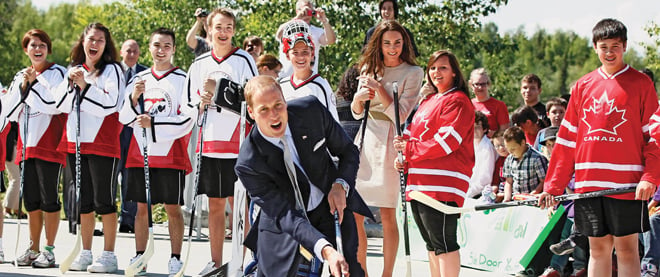‘This place is what Canada is all about’
The ball hockey-playing prince wooed the crowd in four languages
Phil Noble/Reuters
Share

What drew Yellowknife Mayor Gordon Van Tighem to the Northwest Territories 20 years ago, after years in Calgary and Toronto, are some of the same experiences Prince William and Catherine were able to sample during their 40-hour visit to the territorial capital and the wilderness beyond. “You’re on the edge of some of the little remaining, but accessible, wilderness in the world,” says the mayor. “Twenty minutes in any direction you won’t be finding any cigarette packages or Tim Hortons cups, and you can get lost.”
There was little risk of William and Catherine going astray during their whirlwind visit to what the BBC breathlessly described as “the remote settlement of Yellowknife.” The description amused rather than offended the mayor. With almost 20,000 people, representing 120 ethnic groups—and “two McDonald’s”—the mayor considers Yellowknife “a little-big city.” But he couldn’t have been more delighted with William’s glowing description of life above the 60th parallel. “This place is what Canada is all about,” the duke of Cambridge told a cheering crowd of about 3,000 at the civic plaza beside city hall, “vast, open beauty, tough, resilient, friendly peoples. True nature. True humanity.” Behind him were the glistening waters of Frame Lake. Beside him and Catherine on stage were territorial leader Floyd Roland and Aboriginal dancers and drummers. William earned an even bigger roar of approval when he closed his brief remarks by adding his thanks in the languages of the Dene and the north coast Inuvialuit. After opening with a few words of French, the duke looked pleased at acing what may have been his first-ever quadrilingual speech.
The couple, having travelled almost 3,700 km from Charlottetown through three time zones, was allowed a late start Tuesday, and looked the fresher for it. Yellowknife, this time of year, is murder for the sleep deprived. The sun pulls 20-hour days, and the city is bathed in twilight for the remainder of what passes for night. Once up, the couple had a full agenda, “the full meal deal,” as the mayor put it. After opening remarks at the plaza, they watched demonstrations of Dene hand games (a form of gambling) and Inuvialuit high kicks. They also were presented with red Canadian Olympic hockey jerseys with “Cambridge” written across the back. They watched a brief but spirited game of street hockey with a group of young people. William picked up a stick, but failed at three shoot-out attempts to get past goalie Calvin Lowmen, despite the duke’s joking plea that “You’ve got to let one in!”
Much of the trip focused on Aboriginals, who make up half the territorial population, and youth. In the circular legislature they met with members of a youth parliament; one topic the group raised was the challenge of keeping young people in school. Fewer than 16 per cent of Aboriginal students graduate from high school in the territory, and only 4.6 per cent have university degrees.
Later Tuesday, the couple took a 30-minute float plane journey to Blachford Lake, the very definition of remote. There, they were to meet with members of the Canadian Rangers, the country’s volunteer northern home guard. Both William and his brother Harry were named honorary members of the Rangers in 2009. They also had a hands-on tour at the lake of the Dechinta Centre for Research and Learning, a program that combines traditional Aboriginal learning into a university-accredited program. On Wednesday, in a change of plans, the royals were to board a jet to meet with emergency personnel and residents in Slave Lake, Alta. The community was devastated in May after a wildfire destroyed 40 per cent of the town. Organizers had held off announcing the trip until they were certain the visit would not disrupt reconstruction efforts.